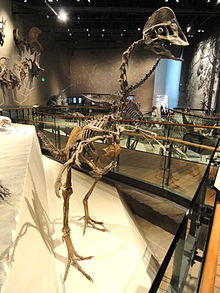Hagryphus
| Hagryphus | |
|---|---|

| |
| Reconstructed skeleton based on the related Anzu, Natural History Museum of Utah | |
| Scientific classification | |
| Domain: | Eukaryota |
| Kingdom: | Animalia |
| Phylum: | Chordata |
| Clade: | Dinosauria |
| Clade: | Saurischia |
| Clade: | Theropoda |
| Family: | †Caenagnathidae |
| Genus: | †Hagryphus Zanno & Sampson, 2005 |
| Type species | |
| †Hagryphus giganteus Zanno & Sampson, 2005
| |
Hagryphus (meaning "
Discovery

To date, only a single species of Hagryphus has been named, in 2005 by
The
Description

As the specific name indicates, Hagryphus giganteus was a particularly large oviraptorosaur, estimated by the describers to have been approximately three meters (10 ft) long, which makes it one of the largest members of the clade Oviraptorosauria (Barsbold, 1976), apart from the later described Gigantoraptor. H. giganteus was estimated to have been 30-40% larger than the next largest known North American oviraptorosaur, Chirostenotes. The hand of the holotype was about a foot long.[1] However, later estimates have been lower: Gregory S. Paul in 2010 gave a length of eight feet and a weight of fifty kilogrammes.[2]
Classification


In 2003 Zanno & Sampson reported the new find as a member of the Caenagnathidae.[3] However, in 2005 they limited the precision of the determination to a more general Oviraptorosauria. Hagryphus would then be the southernmost known oviraptorosaurian from the Americas.[1]
Other known species of North American oviraptorosaurs include Anzu wyliei, Microvenator celer, and Chirostenotes pergracilis. This group of dinosaurs is better known from the Cretaceous of Asia, where forms such as Khaan mckennai, Conchoraptor gracilis and Oviraptor philoceratops have been discovered.
A phylogenetic analysis conducted by Funston (2020) is reproduced below.[5]
| Caenagnathidae |
| ||||||||||||||||||||||||||||||||||||||||||||||||||||||||||||||||||||||||
The results of an earlier analysis by Funston & Currie (2016) are reproduced below.[6]
| Caenagnathidae |
| ||||||||||||||||||||||||||||||||||||||||||||||||||||||||||||
Paleoenvironment

The only known specimen of Hagryphus was recovered at the
Hagryphus shared its
See also
Notes
- ^ .
- ^ a b Paul, G.S., 2010, The Princeton Field Guide to Dinosaurs, Princeton University Press p. 150
- ^ S2CID 220410105.
- PMID 21949721.
- ISSN 2292-1389.
- S2CID 131090028.
- ^ Roberts EM, Deino AL, Chan MA (2005) 40Ar/39Ar age of the Kaiparowits Formation, southern Utah, and correlation of contemporaneous Campanian strata and vertebrate faunas along the margin of the Western Interior Basin. Cretaceous Res 26: 307–318.
- ^ Eaton, J.G., 2002. Multituberculate mammals from the Wahweap (Campanian, Aquilan) and Kaiparowits (Campanian, Judithian) formations, within and near Grand Staircase–Escalante National Monument, southern Utah. Miscellaneous Publication 02-4, Utah Geological Survey, 66 pp.
- ^ Titus, Alan L. and Mark A. Loewen (editors). At the Top of the Grand Staircase: The Late Cretaceous of Southern Utah. 2013. Indiana University Press. Hardbound: 634 pp.
- ^ Clinton, William. "Presidential Proclamation: Establishment of the Grand Staircase–Escalante National Monument". September 18, 1996. Archived from the original on 28 August 2013. Retrieved 9 November 2013.
- .
- ISBN 1-55791-634-9.
References
- Doklady Akademii Nauk SSSR. 226 (3): 685–688.
